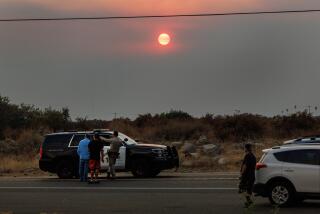AQMD Imposes Smog Controls on Large Bakeries : Pollution: Action is aimed at cutting emissions of ethyl alcohol, which is formed when bread is leavened.
First it was underarm deodorants. Then it was barbecue lighter fluids, leaf blowers and a supermarket shelf full of other personal care and household products.
Now, air pollution authorities have added bread and pastries to a growing list of unlikely air pollution culprits.
On a unanimous vote Friday, the South Coast Air Quality Management District board ordered large commercial bakeries in the four-county air basin to install smog controls on their ovens to capture that sweet aroma of fresh baked bread before it wafts into the air.
The scent may be pleasing to the nose, authorities said, but the 72 ovens at 24 large commercial bakeries in the region are contributing almost as much as one oil refinery does to smog.
The problem is not the odor itself but smog-producing ethyl alcohol, which is formed as the bread is leavened and then emitted as part of the aroma.
The regulation, which takes effect in phases beginning in mid-1993, is expected to add less than a penny to the price of a one-pound loaf of bread.
“The public has consistently said they’re willing to pay more for air quality. I don’t think a cent more for bread is too high a price to pay,” said AQMD board member Stephen Albright.
Bakers said that in view of the region’s formidable air pollution problem--the most severe in the country--opposing the rule would be like opposing apple pie.
“We want to do our part for the environment,” said David E. Cranston, an attorney representing Southern California Bakers Air Quality Assn.
But, Cranston said, the controls will cost bakeries $15 million. “It’s not going to be a piece of cake,” he said.
Bakeries in the region produce 446,700 tons of bread per year. When operating at capacity, one large bakery produces up to 300,000 pounds of more than 100 varieties of bread and other bakery products each day.
The 24 commercial bakeries spew out an estimated 4.1 tons of volatile organic compounds a day. Although that is less than 1% of those emissions coming from motor vehicles, power plants, consumer products and other sources, the bakery emissions nearly equal the pollution produced by a medium-sized oil refinery, AQMD officials said. The new controls are expected to reduce oven emissions an average 83%.
Capping the aroma from all that baking is the latest in a series of unconventional measures aimed at bringing Los Angeles, Orange, Riverside and San Bernardino counties into compliance with federal clean-air standards by the year 2007. Other consumer products already regulated range from common household cleaners to hair sprays.
Sometimes called ethanol, the ethyl alcohol targeted in the bakery rule is a volatile organic compound that reacts in the presence of sunlight with nitrogen oxides to form ozone, a health-threatening air pollutant that makes up 95% of smog.
The emissions from baking bread can be controlled in different ways. A bakery can install an air pollution control device known as a catalytic incinerator at the top of the oven’s exhaust stack to burn off the ethanol fumes. Or, a bed of activated carbon can be installed to absorb organic compounds from the exhaust stream.
The bakery rule adopted Friday was not the first in the state, but it will be the first to take effect.
Last September, the Bay Area Air Quality Management District voted for a less stringent rule that will take effect in January, 1994.
Unlike the AQMD rule, the Bay Area version won approval after a long and controversial battle with bakers. It covers only five commercial bakeries, and calls for smaller emission reductions.
More to Read
Eat your way across L.A.
Get our weekly Tasting Notes newsletter for reviews, news and more.
You may occasionally receive promotional content from the Los Angeles Times.










